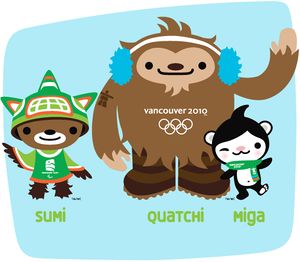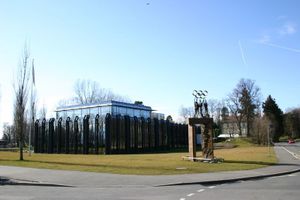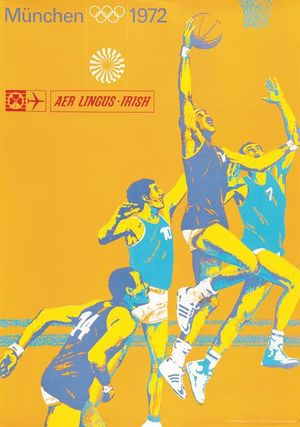Course:The Olympic Mascots
The Olympic Mascots

This group follows the history and story of the modern Olympic Games. We want to show you how our wiki, Quatchi came to be. It was a long and arduous journey that lasted two World Wars, terrorist attacks, cancellations, due dates, and being over budget. This group will look into how and why the modern Olympic Games were established. What were the motivations of the athletes, coaches, and nations? How did the Olympics market the first games, and were they successful? Then we delve into certain Olympics that stand out in history. Why were they significant and what have we learned from them. We want to make clear the social progression that The Olympics went through and underline motivations behind the games. Later we get into how our wiki was conceived. What is its place in the Olympics, and how does it reflect contemporary society.
The Modern Olympics

The modern Olympic were first held in 1896 in Athena, Greece. The modern Olympic games are the leading international sport even featuring summer and winter sports competitions in which thousands of athletes participate in a variety of competitions. Over 13,000 athletes compete at the summer and winter Olympic games in 33 different sports and nearly 400 events. The first, second, and third place of each event will receive Olympic medals; gold, silver and bronze. The Olympics games are organized by the Olympic movement, which consists of international sports federations (Ifs), National Olympic Committees, and organizing committees for each specific Olympic games. Each committee has their responsibilities, for example, the IOC is responsible for choosing the host city for each celebration of the games. Today, many countries compete to host the games because of many benefits: tourism, economic growth, public support from voters, and national pride.
Baron Pierre de Coubertin brought the modern Olympic games back in 1894. He founded the International Olympic Committee, which govern body of the Olympic movement. Baron de Coubertin was a French educator, historian and also considered the father of Olympic Games. The idea for reviving the Olympic Games as an international competition came to Coubertin in 1889, and he spent the following five years organizing an international meeting of athletes and sports enthusiast that might make it happen. Coubertin advocated for the Game center on a number of ideals about sport: he believed that early ancient Olympics encouraged competitions among amateurs rather than professional athletics, and saw value in that. The ancient practice of a sacred truce in association with the Games might have modern implications, giving the Olympics a role in promoting peace. The role was reinforced in Coubertin’s mind by the tendency of athletic competition to promote understanding across cultures, thereby lessening the dangers of war. In addition, he saw the Games as important in advocating his philosophical ideal for athletic competition: that the competition itself, the struggle to overcome one’s opponent, was more important than winning.
The games have grown in scale to the point that nearly every nation is represented. The growth of the Olympic games create distorted values of the Olympic games. Ever since the growth of the games, it has generated more challenges, includes bribery, doping, and boycotts. Athletes are more prone to drugs-usage and also idolize winning over fair competition. The Olympics not only distort sport values of athletics but also values in business/economic point of view for each nation. The game constitutes an opportunity for the host city and country to showcase themselves to the world. The society (each nation) has perceived the Olympic game as an economic benefit. Hosting the Olympics would help increase the host country’s exports, and sends signals about trade openness. The Olympics might increase opportunities for cities to influence local corporations in ways that benefit the local non profit sector and civil society.
Notable Olympics in History


The Olympics act as a competition between nations and not individuals.
They also can be used as a form of protest. Namely where sixteen Black African nations demanded that New Zealand be “expelled from the games for collaboration with racist South Africa in another sporting event” (Czula 20)
By using the Olympics, countries without a political, economical, or military voice can speak out on social injustices and problems. Throughout time, the Olympics have functioned not only as a competition but also a means of expression.
Berlin Summer Games – 1936
In 1931, while Germany was still a democracy, the IOC allotted Berlin for the 1936 summer games. Two years later with the rise of the Nazi party in Germany the games turned into a racial ‘arena’. The Völkischer Beobachter, the Nazi Party's principal organ, wrote that "Blacks have no place in the Olympics” and used the ancient Greeks as a scapegoat to justify their remarks (Large 6). They stated that “the ancient Greeks would turn over in their graves if they knew what modern men were doing with their sacred national games” (Large 6). The games functioned for the Germans as a platform to show the “glorification of the master race” (Czula 21). After protests and boycotts by Jewish and Black Americans assured that there would be no restrictions on Black or Jewish athletes, the games commenced. The Germans were proud and confident in their Aryan athletes, being opposed by the Americans, proving that Germans were wrong about their racial ‘superiority’. Even though the Americans had a recent history of racial inequality, they were the voice of change in allowing Black and Jewish athletes to compete in the 1936 games. The Olympics can act both as a suppressor of equality and also become a precursor to change people’s morality.
Munich Summer Games -1972

The massacre at the 1972 summer Olympics in Munich displayed how the games can be used as a vehicle to voice unheard people. In essence, the Olympics should be a place of international brotherhood and acceptance. It can however, become a platform for social demoralization, which was experienced in 1972. Without having athletes and the ability to protest, Palestinian terrorists took more drastic measures. Czula writes that by “seizing the Olympic microphone by force” the Palestinians used the games as a form of political expression (22). This would set the stage for the Olympics to change from being a meeting of nations to a militarized compound. The Montreal Olympics reacted to the Munich crisis by militarizing their games. Czula writes that, “approximately $100 million was spent for security and16,000 police and troops protected the 12,000 athletes. Hardly the picture of an idyllic gathering of international brotherhood.” (Czula 21) Throughout the cold war era, medal count between countries such as USA, East Germany, and The Soviet Union was used as a political show down. Socialist and democratic athletes were criticized not by their personal effectiveness in winning medals but by their societal effectiveness in producing them (Czula 22).
As we look toward the future, we have to ask questions about the current Olympic games. Are the challenges faced in previous Olympics still present? I believe we have launched ourselves into a new set of problems and challenges.
Olympic changes over the last 10 years.
From the first Olympic games in Athens where there was only nine sports contested the Olympic Games have evolved into what will be a 28 summer sports in the 2016 Olympics in Rio Brazil. While many events come and go there has always been a core of five sports that have been on every Olympic program, these are Athletics (Track & Field), Cycling, Fencing, Gymnastics and Swimming. Since the 2000 Olympic Games in Sydney Australia there have been four sports added and two sports dropped. In 2000 Taekwondo and Triathlon were brought into the games, as well as Rugby 7’s and Golf that are scheduled for their return to the games in Rio 2016 and after the 2008 Beijing Olympics baseball and softball have been dropped. In regards to the Winter Olympics, snowboarding came into the picture in the 1998 games in Nagano Japan with four events of its own which has now spread to six events for both men and women. Another sport that has made a comeback into the winter games after being dropped in 1948 is the nerve racking sport of skeleton which came back into action in 2002.
Each sport has a different reason for being added or dropped because they are all unique in their own way. In some cases a sport does not have popularity throughout the world such as baseball that has the power teams in the Americas and Asia with little competition coming from Europe, Africa or Australia. With Major League Baseball having their season during the Olympic season many of the top athletes could not compete in the Olympics making the talent in the Olympic Games diluted. Since the Olympics is about showcasing the greatest talents in the world, baseball could not work out.
The Olympic Mascots are not only a way for people to connect with the games but they are also a way for the hosts to show off some of their nationality. The three mascots of the Salt Lake City Olympics of 2002 were a Snowshoe Hare named Powder, a Coyote named Copper and an American Black Bear named Coal, each of which were an indigenous animal of the state of Utah. The 2010 Olympics in Vancouver went a different direction in choosing their mascots and did so through Canadian Mythology and the Haida people. The mythology has the wings of a thunderbird and the legs of an American Black Bear who wears a killer whale hat in the artistic style of the Haida people. This was done because of the major aboriginal influence in British Columbia and to pay tribute to the beautiful art done through these groups. The opening and closing ceremonies are a way for the Olympics to introduce the many countries represented as well as their athletes. Not only do the ceremonies show off their own culture but also the culture of each individual nation in the form of each country’s outfit. Again like the mascots of the events, the ceremonies are different for each Olympic event from the beautiful artistic styles at the Beijing Summer Games to the ceremonies in Vancouver where we poked fun of our Canadian stereotypes. As well as showing the culture of each country they also bring out important and well known people to participate in the ceremonies such as Steve Nash and Trevor Linden in Vancouver to such world icons as the Royal Family in the London Ceremonies. Each Host Country has their own hierarchy to what is important to them and what they want to show the world, and with the ceremonies and the mascot they get the opportunity to show it off.
The Vancouver 2010 Mascots.

The emblem of 2010 Winter Olympics, "Ilanaaq the Inukshuk", was picked through an open contest. However, it met criticism from some aboriginal groups over its design. So the mascot artist was selected through a competition.
Through the process where 177 professionals around the world were submitted their ideas, five were made final. In December 2006, VANOC eventually selected concepts from Meomi Design. Formed in 2002, Meomi is a group of Vicki Wong, a Vancouver-born Canadian of Chinese descent who worked in graphic and web design, and Michael Murphy, born in Milford, Michigan, who worked in design and motion graphics.
The mascots are:
Miga: A mythical sea bear, part killer whale and part spirit bear living off the coast of Vancouver Island. She loves surfing in the summer, especially inTofino, and snowboarding in the winter.
Quatchi: A sasquatch. He comes from the mysterious forests of Canada, wears blue earmuffs, and dreams of being a hockey goalie. He loves to travel and learn about the regional dances and cuisines of every place he visits. He carries his camera around his neck wherever he goes. His name comes from "sasquatch".
Sumi: An animal guardian spirit with the wings of the Thunderbird and legs of an American black bear who wears a killer whale-like hat in an artistic style of Haida people. He lives in the mountains of British Columbia and is a passionate environmentalist. His name comes from the Salish word "sumesh," meaning "guardian spirit." His favorite sport is alpine skiing in monoski.
Mukmuk: A Vancouver Island marmot described as "small and friendly", Mukmuk acts as their "sidekick". He has a large appetite. His name comes from the Chinuk Wawa word "muckamuck," meaning "food" or "to eat". As of December 2008 he has joined the other mascots as a stuffed toy.
Works Cited:
Czula, Roman. "The Munich Olympics Assassinations: a Second Look." Journal of Sport & Social Issues. no. 19 (1978): 19-23.
Large, David Clay. ""Darktown Parade":African Americans in the Berlin Olympics of 1936." Project Muse. no. 2 (2007): 6-8.
| The Olympic Mascots | |
|---|---|
 | |
| HIST 104 | |
| Section: | |
| Instructor: | |
| Email: | |
| Office: | |
| Office Hours: | |
| Class Schedule: | |
| Classroom: | |
| Important Course Pages | |
| Syllabus | |
| Lecture Notes | |
| Assignments | |
| Course Discussion | |